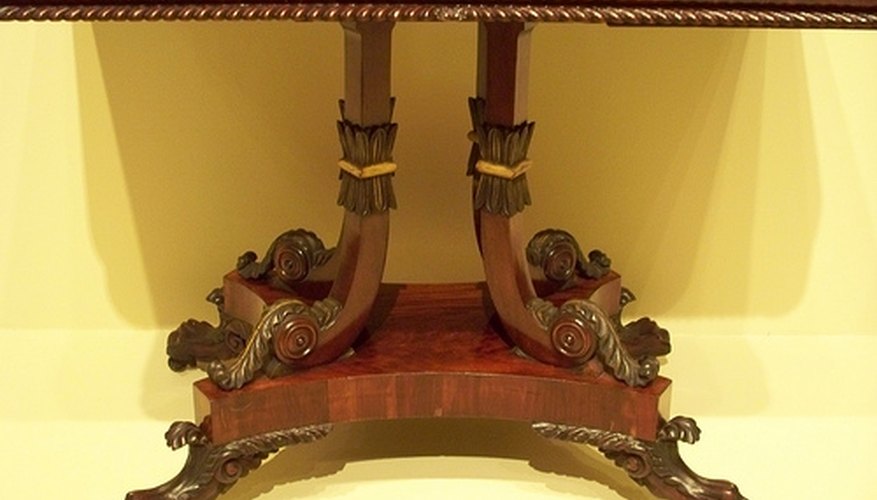Mahogany is the name for various species of straight-grain, dark hardwood with a reddish-brown cast that darkens over time. Today, mahogany comes mainly from Africa and from sustainable forests in Indonesia. Mahogany naturally resists some pests and wood rot. The trunks can grow to 2 yards wide and yield wide planks that are perfect for indoor furniture, musical instruments such as pianos, outdoor furniture and outdoor decks. When you treat mahogany, you apply an agent, usually a liquid or heat, to give it a longer life or protect it against the elements and pests.
Indoor Furniture
Mahogany is most commonly used to make indoor furniture. It is considered one of the most beautiful and durable of furniture woods, but because of overexploitation, true mahogany is becoming harder to find. It occurs frequently in antiques, especially those dating from the Colonial period. To keep mahogany in good condition, dust frequently and clean food or drink spills immediately with a damp cloth, then repolish with a furniture polish especially formulated for mahogany wood. There are special polishes for piano mahogany. A polish with lots of carnauba oil and some beeswax will last a long time, so you'll only need to dust and buff with a soft cloth between applications to maintain the sheen. Use a coaster, mat or trivet when placing food and drink on a mahogany surface. Do not place or rubber or synthetic materials directly on the wood, because chemicals in these can harm the finish. Keep the wood away from direct contact with heating or air conditioning, because these can dry the wood and damage the finish. Avoid direct contact with sunlight, which can bleach the wood colour and dry and damage the finish as well.
- Mahogany is most commonly used to make indoor furniture.
- Keep the wood away from direct contact with heating or air conditioning, because these can dry the wood and damage the finish.
Companies that make mahogany furniture treat the sawn lumber before manufacture. Humidity and woodworm, which is the larva of a wood borer such as beetles, weevils, termites and moths, are the greatest threats to the quality of mahogany. To combat these, manufacturers will apply a chemical anti-woodworm treatment, dry unwanted humidity in a wood kiln then possibly reapply the chemical treatment, followed by a soaking in a wood protectant such as biodegradable deltamethrin diluted with water and light oil. The lumber is then allowed to dry prior to manufacture.
Outdoor Furniture
Outdoor furniture is made mainly from mahogany and teak. At sixty to eighty years, teak has approximately double the life of mahogany, which has a life of thirty to forty years, and teak is less resistant to decay. However, mahogany outdoor furniture can hold a coloured wood preservative or paint, while teak cannot due to its high mineral and silica content. Water washes and precipitation will eventually wash away the red tones in mahogany. Opinions vary about whether to treat outdoor mahogany or not. Some purveyors of mahogany for outdoor use say it is unnecessary to treat outdoor mahogany furniture. If left untreated, it will develop a silver-grey and eventually a darker grey patina. But to prolong its life and keep the original colour, Maine-based Weatherend Estate Furniture suggests giving mahogany outdoor furniture a thorough cleaning and sanding, followed by application of a wood preservative.
- Outdoor furniture is made mainly from mahogany and teak.
- However, mahogany outdoor furniture can hold a coloured wood preservative or paint, while teak cannot due to its high mineral and silica content.
Outdoor Decks
Outdoor mahogany decks need to be restained and repainted periodically to extend their life. They can also be treated with a simple clear sealer every spring before they are subjected to heavy use. Mahogany from Central and South America and the Caribbean is especially prized for decking due to its red cast and density, which makes it resistant to cracking or splitting. When making repairs, sturdy stainless steel nails or screws work best with this dense hardwood. Mahogany is more expensive than pressure-treated lumber for decking.
Contractors differ on what kind of clear wood sealer or clear wood finish (CWF) to use. One contractor recommends a deep-penetrating oil, followed by a locking topcoat that doesn’t crack or peel. Most recommend staying away from any kind of CWF because of the tendency to peel and the need for a time-consuming annual redo.
- Outdoor mahogany decks need to be restained and repainted periodically to extend their life.
- One contractor recommends a deep-penetrating oil, followed by a locking topcoat that doesn’t crack or peel.
